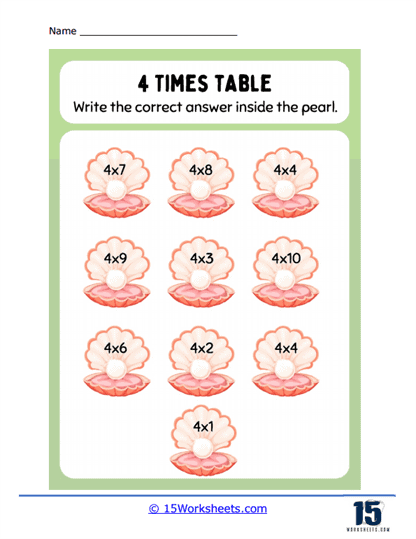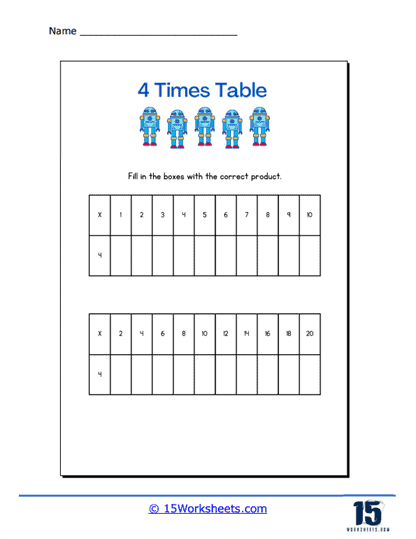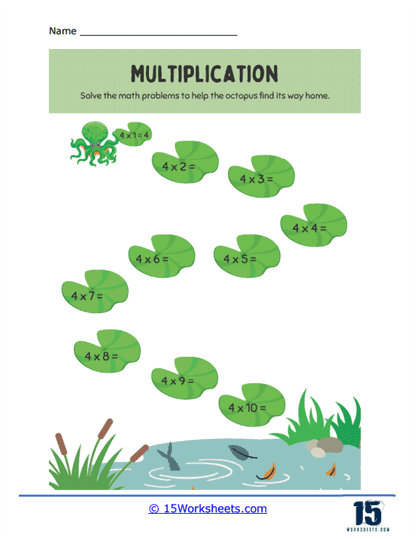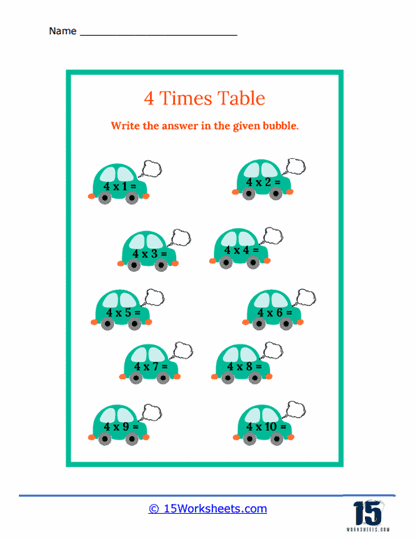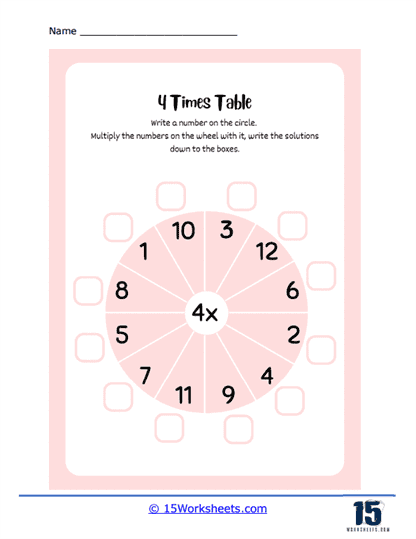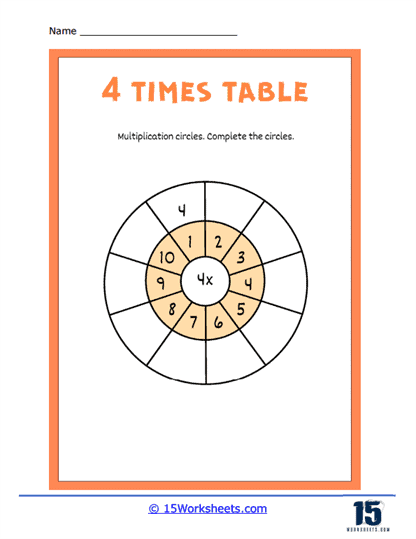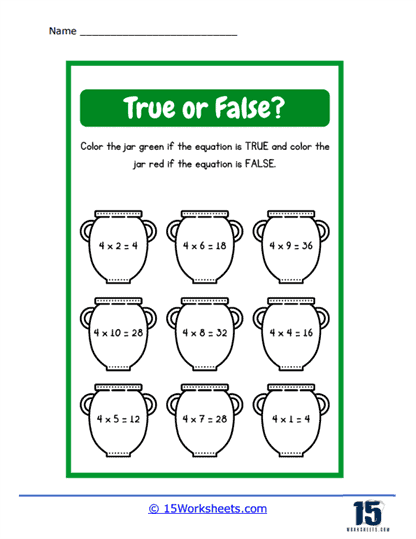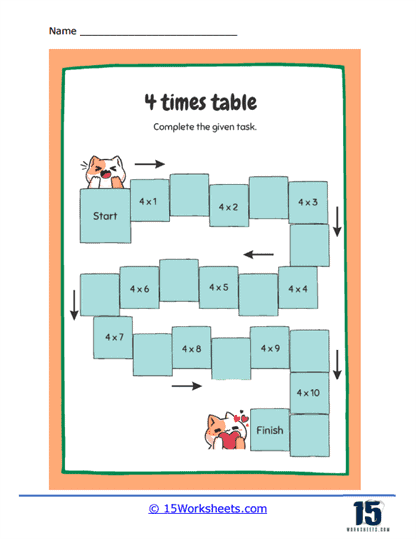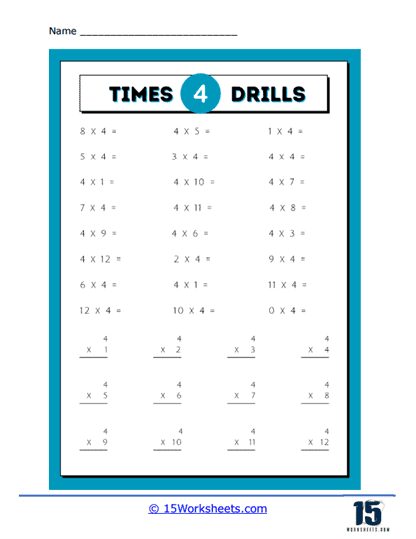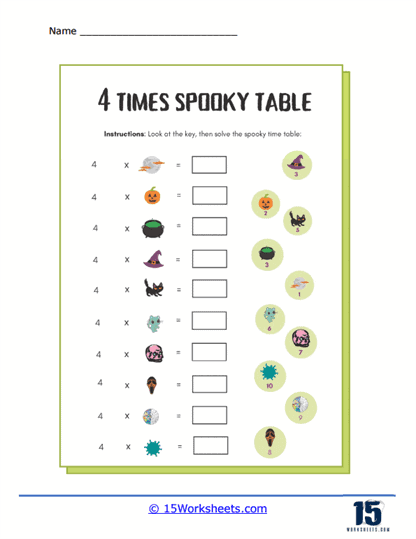4 Times Tables Worksheets
About These 15 Worksheets
Think of these worksheets as tools that help you decode the language of multiplication. With each problem you tackle, you’re honing your analytical abilities and sharpening your mathematical intuition. Beyond the numbers, these worksheets cultivate problem-solving, critical thinking, and logical reasoning skills.
Learning multiplication isn’t just about calculations – it’s about gaining proficiency that empowers you to navigate various scenarios in school and everyday life. So, equip yourself with a pencil, an open mind, and a spirit of exploration, and embark on this enlightening journey into the realm of 4 times table worksheets. With every problem you conquer, you’re progressing toward mastery of multiplication!
The Different Types of Problems
Counting Marvels – Imagine you have groups of marvelous objects – it could be candies, stars, or even unicorns! The worksheets might show you groups with 4 objects each. Your task is to count all the marvelous things. It’s like adding 4, then adding 4 again, and again. This helps you learn about 4 times 1, 4 times 2, and so on.
Arrays of Magic – Are you ready to unleash your artistic talents? You’ll draw arrays of objects, arranging them neatly in rows and columns. For instance, if you have 4 rows of 3 stars each, you can draw little pictures to show 4 times 3.
Clever Matching – Get ready to play a matching game that’s all about multiplication! You’ll see multiplication problems on one side and their answers on the other side. Your mission? Match them up like puzzle pieces. It’s like finding pairs of shoes, but with numbers!
Word Adventures – Brace yourself for some wordy adventures! You’ll read stories that hide multiplication treasures. Like this – “Jake has 4 boxes, and each box has 5 pencils. How many pencils does he have in all?” This is about 4 times 5, because there are 4 groups of 5 pencils.
Creating Multiplication – Flip the puzzle around! You might see repeated addition expressions and need to turn them into multiplication problems. If you read “4 + 4 + 4,” you can turn it into 3 times 4, showing 3 groups of 4.
Drawing Marvelous Arrays – Get ready to draw even more arrays! This time, you’ll create your own arrays of marvelous things. Count the total objects in your arrays to find the answers to multiplication problems.
Magic Word Problems – Time to unravel more word problems! You’ll encounter situations from everyday life, like sharing treats among friends. These problems are like secret codes that can be solved using multiplication.
Challenging Puzzles – Put your thinking caps on! Some worksheets might present you with answers and ask you to figure out the multiplication problem. It’s like solving a puzzle where you get to be the detective!
Effective Approaches to Learning Your 4 Times Tables
One effective approach to helping students learn their 4 times tables is by combining visual aids, interactive activities, and consistent practice. To start, introducing the concept of multiplication as repeated addition can provide a strong foundation. By showing students how 4 times tables relate to adding groups of 4, you’re helping them understand the underlying principle. Visual aids, such as multiplication arrays with objects arranged in rows and columns, can make the concept more tangible and engaging.
Engaging students through interactive activities can also make the learning process enjoyable and memorable. Games like “Multiplication Bingo” or “Four in a Row” can turn learning into a playful experience. Using physical objects like counters or drawing arrays on paper can add a hands-on element that reinforces the concept. Incorporating technology, such as interactive multiplication apps or online quizzes, can appeal to students who are more tech-savvy.
Regular practice is crucial for building fluency. Consistently providing opportunities for students to practice their 4 times tables will reinforce their understanding and memorization. Practice can come in various forms – worksheets with a mix of problem types, timed quizzes to encourage quick recall, and even oral exercises where students take turns quizzing each other.
Creating a positive and supportive learning environment is equally important. Encouraging students to ask questions, celebrate their progress, and learn from mistakes helps build their confidence. Providing praise and recognition for their efforts can boost motivation. Additionally, using real-life examples and word problems that involve multiplication by 4 can show the practical application of this skill.
Incorporating the 4 times tables into everyday activities can solidify their understanding. For instance, during cooking or baking, you can ask students to calculate the total number of items when recipes call for 4 of something. This bridges the gap between the classroom and real life, making the learning more meaningful.
4 Times Tables to 20
0 x 4 = 0
1 x 4 = 4
2 x 4 = 8
3 x 4 = 12
4 x 4 = 16
5 x 4 = 20
6 x 4 = 24
7 x 4 = 28
8 x 4 = 32
9 x 4 = 36
10 x 4 = 40
11 x 4 = 44
12 x 4 = 48
13 x 4 = 52
14 x 4 = 56
15 x 4 = 60
16 x 4 = 64
17 x 4 = 68
18 x 4 = 72
19 x 4 = 76
20 x 4 = 80

